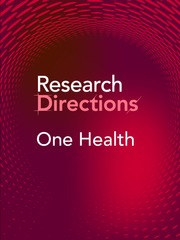Context
The One Health concept explicitly acknowledges that the well-being of humans, animals and environments are linked. These relationships are complex and dynamic, evolving through time. Temporal perspectives also frame biological evolution and contextualise changes in our knowledge base and disease mitigation measures.
One Health approaches, aimed at improving health understanding and outcomes, are interdisciplinary and multisectoral. It is the case, however, that they seldom effectively draw on evidence from disciplines that offer deeper time-depth perspectives, and when they do, this is generally restricted to evolutionary biology and the reconstruction of long-term infectious agent phylogeny based on available genetic sequences (e.g. Düx et al., Reference Düx, Lequime, Patrono, Vrancken, Boral, Gogarten, Hilbig, Horst, Merkel, Prepoint and Santibanez2020). Yet, other disciplines, such as archaeology and history, can address, complement or contextualise the contemporary health challenges that face local and global communities. In a study to characterise the discourse and contributions between disciplines on zoonotic spillover, for example, those that study the past are absent (Sánchez et al., Reference Sánchez, Venkatachalam-Vaz and Drake2021). As a counterpoint to this, it can be argued that full understanding of the complexity of zoonoses should be based on their long-term development from natural history origins, through spillover events, to later anthropogenic adaptations.
Records from the past hold information on long-term changes in human-animal-environment relationships and speak, for example, to processes of domestication, industrialisation, globalisation and changing health in a warming world. Analyses of these records can provide integrated and contextualised biological and cultural records with powerful insights into the complexity of the social-ecological interactions that shaped health experiences. The completed experiments of the past are thus available for us to learn from. Knowledge of past emergence and transmission of specific diseases, for example, can help inform current behaviours and decisions, with the potential to inform risk reduction and disease mitigation (Boualam et al., Reference Boualam, Pradines, Drancourt and Barbieri2021; Seetah et al., Reference Seetah, LaBeaud, Kumm, Grossi-Soyster, Anangwe and Barry2020).
The success of One Health approaches rests not only on the effective analysis and understanding of complex socio-ecological systems and their evolution but also on the effective communication and public acceptance of health messaging. In this regard, there is often popular interest in archaeological and historical narratives, which may be better mobilised to contextualise public knowledge and support improved health communication (Bendrey and Fournié, Reference Bendrey and Fournié2021).
Perspectives from the past are currently undervalued and often overlooked in One Health approaches, and we invite authors to explore how deep time perspectives can contribute to tackling contemporary health challenges, through enhancing understanding of the factors promoting disease emergence and burden, and supporting disease mitigation. Investigating how knowledge of the past can meaningfully and tangibly contribute to improving present health experiences will be a key component in addressing this question.
How to contribute to this Question
If you believe you can contribute to answering this Question with your research outputs, find out how to submit in the Instructions for authors. This journal publishes Results, Analyses, Impact papers and additional content such as preprints and “grey literature.” Questions will be closed when the editors agree that enough has been published to answer the Question so before submitting, check if this is still an active Question. If it is closed, another relevant Question may be currently open, so do review all the open Questions in your field. For any further queries, check the information pages or contact this email onehealth@cambridge.org.
Competing interests
The authors declare none.




